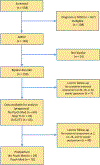Mood symptoms in pregnant and postpartum women with bipolar disorder: a naturalistic study
- PMID: 28665044
- PMCID: PMC6594856
- DOI: 10.1111/bdi.12500
Mood symptoms in pregnant and postpartum women with bipolar disorder: a naturalistic study
Abstract
Objective: We conducted a prospective naturalistic study of pregnant women with bipolar disorder (BD) to evaluate symptoms of BD across childbearing and assess whether pharmacotherapy reduced their severity.
Methods: Assessments were scheduled at 20, 30, and 36 weeks' gestation and 2, 12, 26, and 52 weeks postpartum. Symptoms were assessed using the Structured Interview Guide for the Hamilton Depression Rating Scale-Atypical Depression Supplement (SIGH-ADS) and Mania Rating Scale (MRS).
Results: Pregnant women (N=152) with BD were evaluated; 88 women (58%) were treated and 64 untreated (42%) with psychotropic drugs during pregnancy. Among the 88 women treated, 23 (26%) discontinued their medication in the first trimester and the remaining 65 (74%) were exposed throughout pregnancy or in the second and third trimesters. More than two-thirds (73%) of the women who remained in the study took psychotropic agents postpartum. The mean scores on the SIGH-ADS were in the mild range of depressive symptoms in both the psychotropic-treated and untreated groups in both pregnancy and postpartum. The majority of women had no or few symptoms of mania. Of the pregnant women treated with psychotropic agents, 66% received a guideline-concordant drug, and 34% received either antidepressant monotherapy (for BD I) or mono- or polypharmacy with a variety of other agents.
Conclusions: This sample of perinatal women with BD was characterized by mild residual symptoms of depression independent of pharmacotherapy, which poses a risk for recurrence and impaired parenting. The treatment of childbearing women with BD deserves urgent clinical and research attention to improve psychiatric outcomes.
Keywords: Psychotropic agents; bipolar disorder; mental health; perinatal; pharmacokinetics; pregnancy.
© 2017 John Wiley & Sons A/S. Published by John Wiley & Sons Ltd.
Figures

References
-
- Yonkers KA, Wisner KL, Stowe Z, et al. Management of bipolar disorder during pregnancy and the postpartum period. Am J Psychiatry. 2004;161:608–620. - PubMed
-
- Post RM, Leverich GS, Altshuler LL, et al. An overview of recent findings of the Stanley Foundation Bipolar Network (Part I). Bipolar Disord. 2003;5:310–319. - PubMed
-
- Kendell RE, Chalmers JC, Platz C. Epidemiology of puerperal psychoses. Br J Psychiatry. 1987;150:662–673. - PubMed
-
- Viguera AC, Tondo L, Koukopoulos AE, Lepri B, Baldessarini RJ. Episodes of mood disorders in 2,252 pregnancies and postpartum periods. Am J Psychiatry. 2011;168:1179–1185. - PubMed
-
- Freeman MP, Smith KW, Freeman SA, et al. The impact of reproductive events on the course of bipolar disorder in women. J Clin Psychiatry. 2002;63:284–287. - PubMed
MeSH terms
Substances
Grants and funding
LinkOut - more resources
Full Text Sources
Other Literature Sources
Medical

